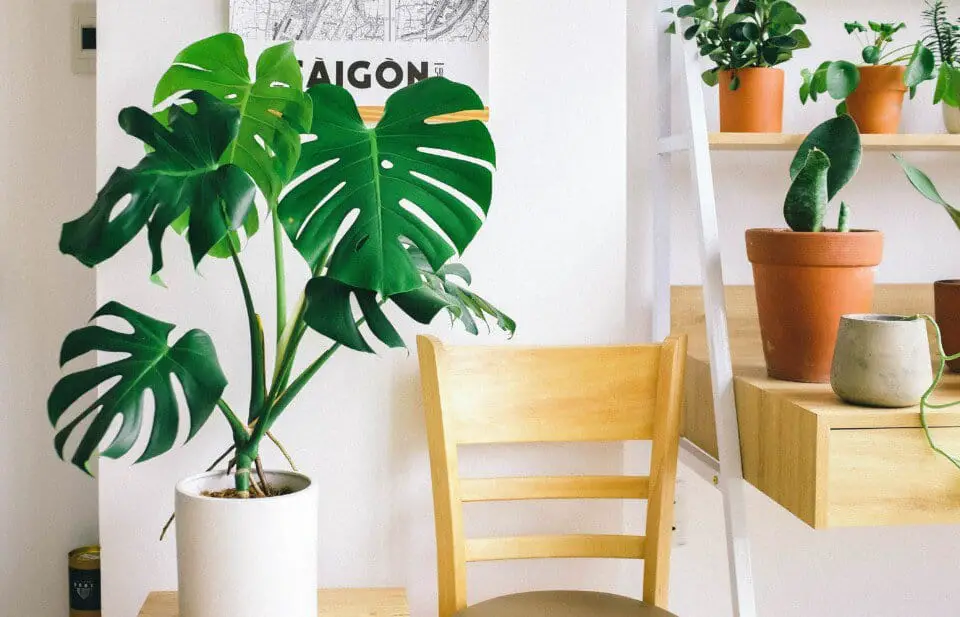Some links in the post are affiliate links and I get a commission from purchases made through some links found in the post.
I remember the day like it was just yesterday because it was one of the most terrifying days I have had this year. My sister was staying over with her daughter, who is two.
So, in the days before they arrived, you should have seen how keen I was on babyproofing the house.
I put the knives away, installed a gate to the stairs, moved sharp items to higher places, and pretty much changed the whole aesthetic in the house.
My neighbor, who adores kids, was with me. And we looked at what we had done and patted ourselves on the back. Great job, or so we thought!
My sister arrived, and in the excitement of the moment, we let my niece wander around the house. Besides, I had already proofed it, and she was safe.
After a while, we decided to look for her because when toddlers become quiet, they are up to something. And indeed, she was, having nibbled on my monstera deliciosa!
I was unsure about its toxicity because I haven’t had to worry much about it – with no kids or pets in the home.
So, we called the doctor and rushed her to the hospital. Luckily, she had not eaten much, but the nurse was happy that we had brought her over.
The reason? The monstera deliciosa is toxic. And if she had eaten more than a few nibbles, we probably would have had to stay at the hospital overnight. This guide details the toxicity of the monstera and how it affects us and our pets.
Is A Monstera Toxic to Humans?
 If you go by what the ASPCA states, the monstera comprises calcium oxalate crystals which are toxic to dogs and cats. But what about humans?
If you go by what the ASPCA states, the monstera comprises calcium oxalate crystals which are toxic to dogs and cats. But what about humans?
This Children’s Health Queensland Hospital and Health Service resource confirms why the nurse was so worried when we brought in my niece.
It turns out that the insoluble calcium oxalate crystals in the monstera can cause an array of symptoms if ingested. These include:
- Burning pain,
- Gastrointestinal complications like nausea and abdominal pain in some cases,
- Swelling of the lips, mouth, throat, and tongue, and
- Difficulty speaking, swallowing, or even breathing owing to throat and mouth swelling.
And while the monstera deliciosa fruit is often considered edible, this resource claims that consuming it may adversely affect the human body. Some people may experience hives or itchy rashes upon consuming it.
Tidbit
What happens if you touch the monstera? Most gardening guides encourage people to wear gloves when handling the monstera, especially when pruning it.
That’s because the sap of the monstera is quite irritating and can cause rashes when you touch it. The discomfort often goes away after washing the sap off with soap, but you are better off avoiding it by wearing protective clothing.
But in this case, we will focus on what happens when humans and pets ingest the monstera plant parts.
Monstera Toxicity Rating
Currently, monstera has a toxicity rating of 2. How bad is a rating of 2? Well, toxicity falls into 4 categories:
- Rating 1: Plants in this category cause various issues when you come into contact with them. These include itching, rashes, and redness. Sometimes, contact can also result in blisters that can feel like burns on the skin.
- Rating 2a: The first 2 rating relates to plants with fast onset oxalates, such as the monstera. These plants comprise oxalate crystals in tiny sizes in the form of needles. If you consume such plants, you will experience any of the symptoms earlier described. Often, they result in breathing problems.
- Rating 2b: If late-onset oxalates are in play, you will not immediately feel the toxin’s effect. However, the oxalates, in this case, take home in the kidneys, which puts you at risk of kidney damage. While nausea is not common with monsteras, plants in this category are often associated with gastrointestinal complications.
- Rating 3: Ingesting plants in this category can cause issues like diarrhea, nausea, and vomiting. But the situation is not likely to escalate to become life-threatening.
- Rating 4: This rating is relatively high and implies that ingesting the said plant can damage the heart, liver, brain, and other vital organs. Thus, consuming even a tiny amount of such a plant can have serious consequences. And you should call the poison center as soon as possible.
You can refer to this guide for more information about plant toxicity. Kindly note that the only exception to this toxicity is in the ripe fruit of the monstera deliciosa as this is edible.
Signs of Poisoning
The monstera is relatively low on the toxicity list. However, that does not mean that it does not adversely affect humans who consume it. If you suspect that your child has consumed the monstera leaves, you should look out for signs like:
- Drooling,
- Vomiting,
- Difficulty breathing or swallowing,
- Crying, and
- Signs of irritability regarding the mouth.
If your child can talk or signal what is happening, they will likely point to their mouth. And you can also ask them if they have eaten the monstera. Better yet, look for damage in the monstera, and if you can’t find the missing leaves, chances are high your child has eaten them.
What to Do
 Now that your child has swallowed a toxic monstera plant, what should you do?
Now that your child has swallowed a toxic monstera plant, what should you do?
- Do not force the child to vomit. If the child vomits of their volution, that is okay. However, please resist the urge to make them do so because that would only exacerbate the burning sensation and lead to problems like choking.
- Find any plant parts in their mouth or hands and get rid of them.
- Give them some water to help cool the burning sensation. And also, wash the area around the mouth and any parts that have touched the plant to provide some relief.
- Inspect their skin, tongue, mouth, and all parts that have touched the plant.
- Call the nearest poison control system (based on where you live). They will direct you on whether you need to take the child to the hospital or not. Please note that you should do this even when you think the child will be okay. Allow the experts to weigh in on the symptoms so you can treat them immediately.
- If you need to take the child to the hospital, carry the monstera or part of it with you. Identifying the source of the toxicity goes a long way in helping the medical officers find the right treatment for the child.
Please don’t wait until you notice symptoms. Sometimes, symptoms appear when the damage is quite severe, e.g., when the child starts suffering breathing problems.
Act immediately if you notice something is amiss, and you will avoid a lot of stress. Also, the above recommendations apply to adults.
Is A Monstera Toxic To Dogs?
As I mentioned when covering the toxicity of the monstera to humans, this plant contains insoluble calcium oxalate crystals in its leaves and stems.
And unfortunately, A monstera is toxic to dogs which can be a problem because dogs love nibbling on just about anything in their vicinity.
So, what happens when dogs consume the monstera leaves or stems? The crystals in the monstera are in place as means of defense.
And when your dog bites on the plant, the needle-like structures deter the dog from taking another bite by releasing raphides that end up lodged in the dog’s mouth. In this position, they start irritating the dog, resulting in adverse symptoms.
Point to note: Consuming monsteras is one way that your dog can suffer irritation. Brushing up against it is another risk as this can result in sap getting into contact with the dog’s skin, thus irritating it. More information is available in this guide.
Signs Of Toxicity
An easy way to tell that your dog has eaten your monstera is to look for missing plant parts. Moreover, it would help if you were on the lookout for toxicity signs such as:
- Diarrhea,
- Nausea,
- Vomiting,
- Drooling,
- Choking,
- Swelling of the mouth, tongue, or throat, and
- Difficulty swallowing.
See how similar they are to what happens to humans who have consumed the monstera?
It owes to the action of the raphides which lodge in the mouth, throat, and even gastrointestinal tract when you consume monstera plant parts.
Please note that these symptoms can escalate within a short period. For example, if your dog’s throat starts swelling, it could suffer difficulty breathing, which can be fatal if not dealt with promptly.
How Much Does Monstera Toxicity Affect Dogs?
The degree of toxicity depends on a few factors:
- General health condition of the dog – a dog whose immune system is already compromised is more likely to show more signs of poisoning,
- The age of the dog – younger and older dogs are at more risk compared to young adult dogs, and
- The size of the dog – the bigger the dog, the less the risk of severe toxicity.
You will be happy to know that consuming a monstera will likely not kill your dog. Phew! However, the caveat is if the dog is unwell or starts showing signs of swelling or difficulty swallowing and breathing.
What Should You Do?
If you suspect your dog has eaten any monstera part, you should:
- Encourage the dog to drink water to alleviate some of the discomfort,
- Call the ASPCA animal poison control center to get advice on the best course of action based on the current symptoms exhibited by your dog, and
- Take the dog to a vet if advised to do so by the ASPCA animal poison control center or if the symptoms start worsening.
It is always best to protect your dog from consuming the monstera again. Usually, dogs that have suffered the effects of eating the monstera will think twice before eating it again.
But to be safe, move the plant to a spot the dog cannot access.
Is A Monstera Toxic To Cats?
 Cats will suffer a similar fate to dogs as a monstera is toxic to cats. Like in the dogs’ case, the plant releases raphides to protect itself from the attack.
Cats will suffer a similar fate to dogs as a monstera is toxic to cats. Like in the dogs’ case, the plant releases raphides to protect itself from the attack.
And these substances irritate the cat’s mouth and gastrointestinal tract within 30 seconds of consuming the plant parts.
As a result, the cat is unlikely to eat the plant much because the adverse symptoms would set in almost immediately.
However, the cat will likely suffer a great deal of irritation owing to its small size. And the cat will exhibit the following symptoms:
- Drooling,
- Vomiting,
- Swelling on the face, and
- Burning on the tongue.
These symptoms make it hard for the cat to consume other types of food and can also result in difficulty breathing.
The cat would start pawing at its mouth or scratching it to alleviate the discomfort. And you can always look out for such signs when you suspect the cat has eaten the monstera.
What to Do
In most cases, the irritation goes away, especially when the cat consumes a small part of the monstera. But in some, you may need to get involved. Below are the steps you can take:
- Rinse the cat’s mouth – do not allow it to swallow the water as this would only move the calcium oxalates to the stomach and trigger more irritation.
- Feed the cat some milk – if the cat cannot drink the milk, do not force it down its mouth. Instead, follow through with the steps below.
- Call the ASPCA animal poison control center or your vet and figure out the way forward. Sometimes, you may need to seek emergency medical services for the cat.
Given the small stature of cats, a small monstera plant part can easily cause a lot of damage. But fatality is not common.
Protecting Your Cat
Cats are naturally inquisitive. And unlike dogs that will likely stay away from the monstera, your cat could still try to nibble on the plant even after the adverse effects. You can keep it away from the plant by:
- Spraying the cat with water when it nears the plant (only effective when you are around),
- Using a natural repellent spray on the plant to deter the cat from nearing it,
- Mulching the monstera with stone or other materials that are unfriendly to cats to keep them from using the monstera pot as a litter box,
- Hanging the monstera away from windows or any structures the cat can use to get to the plant, and
- Planting a cat-friendly plant that the cat can nibble on, e.g., cat-nip.
The best way is to keep the plant out of reach as much as possible.
Is A Monstera Toxic To Birds?
Birds generally love being around plants and use them as perching points and food. So, it is likely that your bird would want to eat the monstera. But would this be in its best interests?
According to the American Society for the Prevention of Cruelty to animals, monstera plant parts contain calcium oxalate crystals which irritate the gastrointestinal tract so a monstera is toxic to birds.
And the same fate would await your bird if it ate the plant.
What happens to birds that eat monstera plant parts? Irritation and swelling are common. You can alleviate the discomfort by patting the bird and offering it clay bird supplements.
If the bird looks like it’s struggling, call the ASPCA animal poison control center or contact your vet for the next step.
Fatality is not common with birds, but it always helps to be careful. You are better off removing the monstera from the home because treating toxicity in birds is often complicated.
Is A Monstera Toxic To Fish?
 The ASPCA lists the monstera as toxic to dogs and cats. But what about fish? You can grow your monstera in a fish tank.
The ASPCA lists the monstera as toxic to dogs and cats. But what about fish? You can grow your monstera in a fish tank.
However, since it contains calcium oxalates, you must separate the fish from the plant’s leaves to ensure the fish does not feed on these parts.
But this is only necessary for vegetarian fish. Else, you can leave the plant in the aquarium, and the fish would not come to any harm.
Using a monstera in an aquarium is good as it cleans the water and filters it, making it suitable for your fish. But if your fish feeds on leaves, ensure you add a barrier to be safe.
Is A Monstera Toxic to Rabbits?
Just like with cats and dogs, the monstera is toxic to your rabbit and can harm your rabbit. But the difference here is that your rabbit will likely keep eating the plant despite the release of the raphides.
And that means it will eat much more than a dog or cat, which can result in fatality. Yes, it’s that serious. To make matters worse, rabbits will not stop eating the monstera even after suffering adverse effects.
They will keep looking for it and nibble on it once they find it. They may not know the difference between the monstera and other plants and may eat it unknowingly.
Signs of Toxicity
The raphides in the monstera will irritate the gastrointestinal tract in rabbits, resulting in:
- Vomiting,
- Drooling
These signs appear within hours of ingestion. And the best way to deal with the onset of the symptoms is to seek emergency medical intervention for the rabbit.
The rabbit should make a full recovery with proper medical care. Keep the monstera away from the rabbit because it is none the wiser. Even spraying it won’t help, as you would with the cat.
Can Your Monstera Recover After Being Damaged?
Worried that your monstera has suffered damage and won’t grow well? You can put those thoughts in the backseat.
A monstera is very hardy and will recover fully if you prune the damaged parts, give it enough light, and water it adequately.
Final Thoughts
 If you have a pet or young child at home, you are better off moving the monstera outside the home or hanging it to keep it out of reach.
If you have a pet or young child at home, you are better off moving the monstera outside the home or hanging it to keep it out of reach.
Hanging the plant will not work in homes with birds, so you may want to move it outdoors to protect your pet. Happy Gardening!
USEFUL RESOURCES
Pet Care Animal Poison Control Toxic and Non-Toxic Plants: Mother-In-Law
Children’s Health Queensland Hospital and Health Service: Fruit salad plant (Monstera deliciosa)
California Poison Control System
Washington State University Extension: Poisonous Plants and Pets
Toxic Plants and Companion Animals
The Garden Factory Inc.: Plants Toxic to Dogs & Cats

